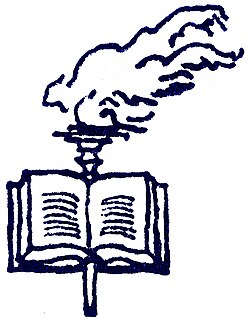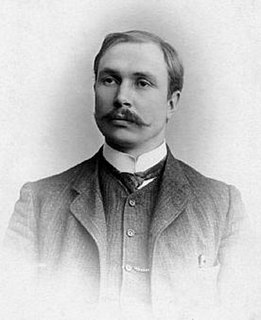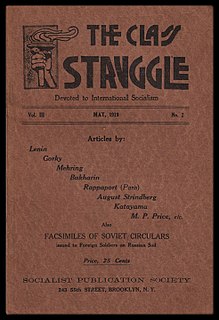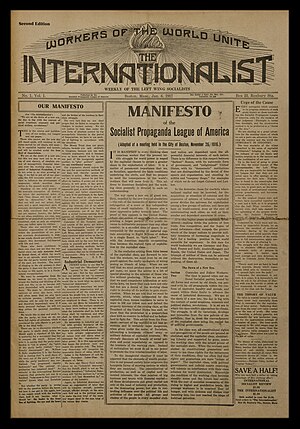
The Socialist Party of Canada (SPC) was a political party that existed from 1904 to 1925, led by E. T. Kingsley. It published the socialist newspaper Western Clarion.

The Communist Labor Party of America (CLPA) was one of the organizational predecessors of the Communist Party USA.

The Proletarian Party of America (PPA) was a small communist political party in the United States, originating in 1920 and terminated in 1971. Originally an offshoot of the Communist Party of America, the group maintained an independent existence for over five decades. It is best remembered for carrying forward Charles H. Kerr & Co., the oldest publisher of Marxist books in America.

Charles Emil Ruthenberg was an American Marxist politician and a founder and head of the Communist Party USA (CPUSA).

Leon "Leo" Jogiches, also commonly known by the party name Jan Tyszka, was a Polish Marxist revolutionary and politician, active in Poland, Lithuania and Germany.

Yrjö Elias Sirola was a Finnish socialist politician, writer, teacher, and newspaper editor. He was prominent as an elected official in Finland, as minister of foreign affairs in the 1918 Finnish Socialist Workers' Republic, a founder of the Communist Party of Finland, and as a functionary of the Communist International.

Mark Andreyevich Natanson was a Russian revolutionary who was one of the founders of the Circle of Tchaikovsky, Land and Liberty and the Socialist-Revolutionary Party. In 1917, he was a leader of the Left Socialist-Revolutionaries, which supported the Bolsheviks during the October Revolution. He was the uncle of Alexander Berkman.

Benjamin Gitlow was a prominent American socialist politician of the early 20th century and a founding member of the Communist Party USA. During the end of the 1930s, Gitlow turned to conservatism and wrote two sensational exposés of American Communism, books which were very influential during the McCarthy period. Gitlow remained a leading anti-communist up to the time of his death.

Robert Berkeley "Bob" Minor, alternatively known as "Fighting Bob," was a political cartoonist, a radical journalist, and, beginning in 1920, a leading member of the American Communist Party.

Alfred Wagenknecht was an American Marxist activist and political functionary. He is best remembered for having played a critical role in the establishment of the American Communist Party in 1919 as a leader of the Left Wing Section of the Socialist Party. Wagenknecht served as executive secretary of the Communist Labor Party of America and the United Communist Party of America in 1919 and 1920, respectively.

The Left Wing Section of the Socialist Party was an organized faction within the Socialist Party of America in 1919 which served as the core of the dual communist parties which emerged in the fall of that year—the Communist Party of America and the Communist Labor Party of America.

Louis C. Fraina was a founding member of the American Communist Party in 1919. After running afoul of the Communist International in 1921 over the alleged misappropriation of funds, Fraina left the organized radical movement, emerging in 1926 as a left wing public intellectual by the name of Lewis Corey. During the McCarthy era, deportation proceedings were initiated against Fraina-Corey. After a protracted legal battle, Corey died of a cerebral hemorrhage before the action against him was formally abandoned.
The Left Wing Manifesto is the name bestowed upon two distinct programmatic documents of the Left Wing Section of the Socialist Party during the factional war in the Socialist Party of America of 1919.

The Class Struggle was a bi-monthly Marxist theoretical magazine published in New York City by the Socialist Publication Society. The SPS also published a series of pamphlets, mostly reprints from the magazine during the short period of its existence. Among the initial editors of the publication were Ludwig Lore, Marxist theoreticians Louis B. Boudin and Louis C. Fraina, the former of whom left the publication in 1918. In the third and final year of the periodical, The Class Struggle emerged as one of the primary English-language voices of the left wing factions within the American Socialist Party and its final issue was published in 1919 by the nascent Communist Labor Party of America.
Eteenpäin was a Finnish-language daily newspaper launched in New York City in 1921. The paper was the East Coast organ of Finnish-American members of the Communist Party USA. The paper moved to Worcester, Massachusetts in 1922 and to Yonkers, New York in 1931. In 1950 Eteenpäin was merged with the Communist Party's Midwestern Finnish-language daily, Työmies to create Työmies-Eteenpäin, which continued to be published from Superior, Wisconsin into the 1990s.
The 1st Congress of the Communist International was an international gathering of communist, revolutionary socialist, and syndicalist delegates held in Moscow which established the Communist International (Comintern). The gathering, held from March 2 to 6, 1919, was attended by 51 representatives of more than two dozen countries from around Europe, North America, and Asia.

The Russian Socialist Federation was a semi-autonomous American political organization which was part of the Socialist Party of America from 1915 until the split of the national organization into rival socialist and communist organizations in the summer of 1919. Elements of the Russian Socialist Federation became key components of both the Communist Party of America and the rival Communist Labor Party of America as "Russian Federations" within these organizations. Following the unification of these two groups in 1921, the resulting unified Russian Communist Federation gradually evolved into the so-called Russian Bureau of the Communist Party, USA.

The Revolutionary Age was an American radical newspaper edited by Louis C. Fraina and published from November 1918 until August 1919. Originally the publication of Local Boston, Socialist Party, the paper evolved into the de facto national organ of the Left Wing Section of the Socialist Party which battled for control of the Socialist Party throughout the spring and summer of 1919. With the establishment of the Left Wing National Council in June 1919, the paper was moved from Boston to New York City gained status as the official voice of the nascent American communist movement. The publication was terminated in August 1919, replaced by the official organ of the new Communist Party of America, a weekly newspaper known as The Communist.
Isaac Edward "Ed" Ferguson (1888–1964) was a North American lawyer and political activist. A founding member of the Communist Party of America, forerunner of the Communist Party, USA, Ferguson is best remembered a co-defendant and attorney in a highly publicized 1920 trial together with party leader C. E. Ruthenberg for alleged violation of New York state law against so-called "criminal anarchism." Following conviction and a term served at Sing Sing prison, Ferguson withdrew from radical politics to become a prominent Chicago civil rights attorney.

The Executive Committee of the Communist International, commonly known by its acronym, ECCI (Russian acronym ИККИ), was the governing authority of the Comintern between the World Congresses of that body. The ECCI was established by the Founding Congress of the Comintern in 1919 and was dissolved with the rest of the Comintern in May 1943.
















